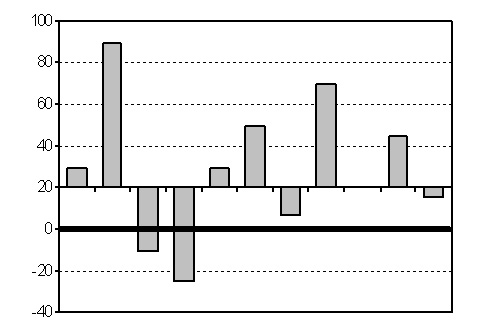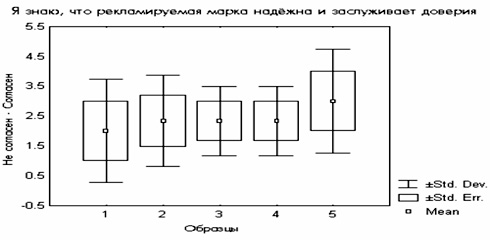Market research
Evaluation of ad efficiency
Estimation of advertising effectiveness after its coming out
The main purpose of an advertisement is informing potential consumers about a product and its advantages and to encourage them to buy it. Hence the criteria of its effectiveness are the degree of awareness of potential consumers about the product or service and involvement in consumption.
These criteria may seem simple, but when working with them, we may face particular difficulties. Successful penetration of advertising images in people’s minds may be considered as knowledge about the existence of the firm, about a particular brand, its advantages; the knowledge may be accompanied by a positive or negative attitude. All these positions present certain interest and deserve being studied. But this knowledge is not necessarily the result of the advertisement and finding this out concerns public opinion rather than the advertisement’s effectiveness. The information about the brand might have been obtained from films, literature, acquaintances or personal experience. The direct impact of advertising is expressed in the awareness of the advertising material and may be determined by measuring this particular criterion. The only objective criterion is the ability of people to reproduce most of the content of the advertisement. However, not only a single catchy fragment of the commercial or the slogan are significant - suck tricks are easy to remember. Respondents should be able to reproduce the elements significant in the advertiser’s opinion: company name or product name, its main advantage or distinguishing feature. It isn’t easy to make a question covering all key elements for the interviewer.
The problem is that interviewers themselves, as average viewers and readers, do not necessarily remember all advertising videos their respondents may mention. During the training, they have to get acquainted with samples of advertising messages. Before the interview, they have to monitor the advertisement on TV and in the press for some time. Monitoring is also necessary because, firstly, it enables them to determine the frequency of the advertisement’s appearance and, secondly, to get acquainted with their messages before analyzing their contents. It is useless to try to find out why a commercial or an ad is popular or unpopular if there is no data about the frequency of its coming out. Actually, almost all its success (or easy retention in memory) may have been due to buying prime time. Correlation of the schedule of the advertising message’s demonstration – on what channel and how often the ad was shown or in what editions the ad was published – and its memorability with different groups of people provides a rich material to find out the factual rating of TV programs, indirect estimation of the number and type of the readers of magazines and newspapers and the ads’ memorability.
"Penetration"
The degree of penetration of advertising information in consumers’ minds is a simple and clear criterion of the operational effectiveness of advertising. But it is only the definition of the conception that is clear; for its practical measuring, there are various methods. The degree of penetration of advertising information is measured as a percentage of people who remember it out of the total number of respondents. It is not just the knowledge about the company or the brand, but the knowledge of the advertisement message which may be presented by different advertising vehicles.
That is why measuring the degree of penetration concerns the contents of the advertisement message, not the trademark or the advertisement image. A stricter sign of assimilating advertising information would be its complete or partial reproduction by the respondent, but to simplify the procedure, measurement methods usually focus on recognition.
For example, Gallup-Robinson method implies answering such questions as “Have the readers of this edition seen the advertisement of this trademark?” According to Starch method the respondent is given a selection of ads and has to pick out the ads he has seen before. The Vu/Lu method (which means “seen this, read this” in French) registers superficial and deep attention.
We should distinguish between remembering the text message of an advertisement and the pictorial and image part of it. As the latter has subordinate function, assimilation of the text message should be considered remembering advertising information.
"Involvement in consumption"
Due to older age of printed advertising, the classic criterion connecting familiarity with the advertisement and consumption is the Netapps index providing data about the percentage of people who bought the product due to the advertisement’s effect on them. Due to the technical development of the media, today we apply the index of effectiveness of advertising effect to electronic media. The "involvement in consumption" index has become versatile. This value shows the correlation between the familiarity of the commercial/ad and the consumption of the product it advertises. The index is determined as the difference between two percentage values: the percentage of people who use the product among the people who remember the ad and the percentage of people using the product among those who do not remember the ad.
As a person may be a constant consumer of some product without even knowing of its advertising, this index may be represented by negative values, too. The positive values of the involvement index mean that people buying the product probably know about its advertising and, consequently, the consumption of the product must be the result of the advertisement’s effect. Low or negative values of the index show that the product’s consumption probably was not affected by the advertisement and the people buying the product must not know about it.
It should be borne in mind that the question about consumption of the advertised product concerns products intended to satisfy immediate needs of consumers, for example, packaged products: food, clothes, perfume, cosmetics, medicines, household appliances, some types of entertainment – films, tours, lotteries. The advertisement which does not have consumption value for consumers as immediate users (advertisement of banks, construction technologies, company image, etc.) is excluded from the involvement index.
Indexes of different strictness degree
When planning methods of measuring this index, it is necessary to determine what is considered to be consumption and what criterion this determination is based on. In some cases this characteristic cannot be described as the number of purchases within a period as some things are bought only once a week while others are bought once in several months and such purchases as a vacuum cleaner cannot be applied the regularity criterion to at all. We also cannot expect that people, even impressed by the advertisement, will see the film they have seen again. That is why in terms of different groups of goods, different consumption criteria are used: regular consumption (once a week, month, etc.), frequent consumption (not less that 2, 3 or 5 times), repeated consumption (the first purchase was not the last) and consumption that has occurred once. If the criteria are selected correctly, the quantitative value of this index allows us to compare various products – cars or toothbrushes, whatever. Given the data about the effectiveness of advertising messages, we can judge what the reasons for their popularity were.
We should remember that experimental comparison of advertising material samples in lab conditions allows us to predict (with much probability) their memorability but not the ability to encourage people to buy the product. Even the most sophisticated imitation of the decision-making situation cannot take into account all accidental impacts each of which may play a decisive role.
The values obtained with the help of these indexes are very expressive as compared with other criteria of advertising campaigns. The bar chart below shows how much higher or lower than the statistically determined average (for this group of products) number of people who remember the advertisement and the number of consumers in the group of people who remember the ad and in the group of people who do not remember the ad.
It is possible to obtain quantitative results in the course of traditional focus groups by filling out questionnaires by their participants. The form of the questionnaire may be developed according to the current objective, but there are also standard methods of registering consumer reactions.
A classic means of advertisement estimation is VRP - viewers' reactions profile. In its original form it contains 53 judgments grouped in 7 general factors – scales for advertisement estimation. However, it is so cumbersome (estimation of several advertising samples by 53 criteria may take up to two hours) that its simplified variants are often used.
Estimation values are presented in the form of a box-and-whiskers plot where the central point shows the average estimation value that the sample gets and the box presents the dispersion – the area where most estimations are located. The whiskers present the range – the interval between the expected minimal and maximal estimations. An example of such estimation is shown below.

Estimation of advertising effect significantly reduces uncertainty of marketing decisions. The demand for studying the impact of advertising caused the appearance of numerous instruments of measuring different aspects of communicative effectiveness. The method of scaling consumer reactions is not limited to the VRP technique. Simpler (but not primitive) techniques make it possible to register emotional attitude to advertisement (EQ – emotional quotient scale), how well the advertisement content is remembered (folder tests, trial issues, complex imitations), peculiarities of perception of advertising samples (lab tests with the help of special equipment – tachystoscopes, eye movement monitoring equipment; attention timekeeping, linguistic and semiological tests). Testing methods should not be confused with the methods of estimation by eye – a set of criteria using which the author of the advertisement or its client can estimate how much it corresponds to theoretical canons without carrying out any special field research.

Depending on the time when these measurements take place, the research may be called a pre-test or a post-test (that is, the indexes are measured before or after marketing actions) or tracking research which monitors the advertisement’s effect within a long period.
| E-mail:rprg@rprg.ru |
|
Site by - WebCait.Ru | ||||||||||||

